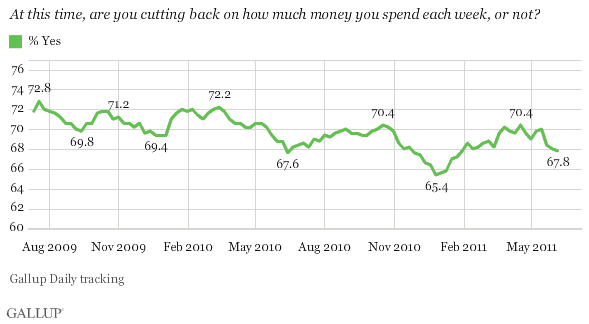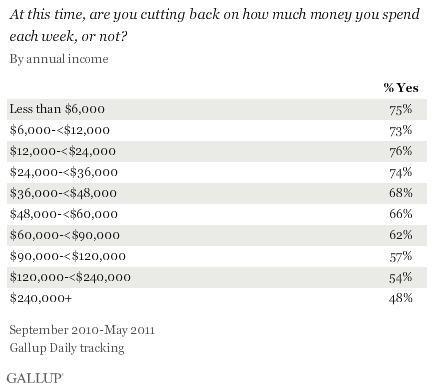PRINCETON, NJ -- Americans have in recent weeks become slightly less likely to say they are cutting back on their weekly spending, suggesting that actual consumer spending may increase as summer gets underway.

Gallup has since June 2009 asked approximately 800 Americans each week: "At this time, are you cutting back on how much money you spend each week, or not?" The results in the accompanying chart are based on five-week rolling averages that include about 3,500 interviews each. Throughout this period, about two-thirds of Americans or more have said they are cutting back on spending, ranging from a high of 73% in July 2009 to a low of 65% in December 2010.
Gallup did not ask this question prior to June 2009, meaning there is no available comparison to times when the economy was booming and when economic confidence was high, such as the late 1990s. But in at least the last two years, the results show that the majority of Americans consistently view themselves as making an effort to cut back on spending, which in turn underscores the idea that most Americans are looking for ways to save money.
"Cutting Back" an Early Indicator of Actual Spending
A special Gallup analysis shows that the relatively small variations in responses to this question over time are related to changes in actual self-reported spending. More specifically, over the last two years, increases in the percentage of Americans saying they are cutting back on spending based on five-week rolling averages have predicted a decrease in average reported spending a week later. Conversely, decreases in the five-week rolling average have been followed by increases in spending a week later. These statistical relationships are not extremely strong, but suggest that when there are changes in the percentage of Americans telling survey interviewers they are cutting back on their spending, actual spending -- at least as measured by Gallup's spending measure -- does, in fact, change in the following weeks.
For example, 68% of Americans reported cutting back last June. The percentage rose to more than 70% by the fall, and then dipped to the low point of 65% by late December. This drop in reports of cutting back on spending at year's end was correlated with an increase in actual spending during the holiday season. The percentage of Americans cutting back on spending climbed again in the first months of this year. Now, as June begins, the five-week rolling average is down slightly. History suggests that at least a modest rise in spending could ensue in the coming weeks.
Last summer, the drop in self-reports of cutting back on spending was fairly short-lived. One indicator of economic activity to watch this summer will be the extent to which this measure stays at this lower level, or continues to drop, in the months ahead.
Even Higher-Income Americans Say They Are Cutting Back
Higher-income Americans are less likely to say they are cutting back on spending than are those who have lower incomes. Still, almost half of those making $240,000 a year or more say they are cutting back.

Implications
The significant majority of Americans consistently report that they are cutting back on the amount they are spending each week. This may represent a "new normal" in which Americans are adjusting to a less robust economy, or a more basic element of human psychology that manifests itself in a need to present oneself as frugal.
These self-reports of cutting back on spending appear to provide an early indicator of actual spending. As the nation enters the summer vacation season, Americans' reports of cutting back are trending slightly downward -- as they did last June. This suggests there will be at least a modest uptick in spending in the weeks ahead. The direction of this consumer attitude throughout the summer will help measure the health of the consumer side of the economy for the end of the second quarter and into the third quarter of the year.
Gallup.com reports results from these indexes in daily, weekly, and monthly averages and in Gallup.com stories. Complete trend data are always available to view and export in the following charts:
Daily: Employment, Economic Confidence and Job Creation, Consumer Spending
Weekly: Employment, Economic Confidence, Job Creation, Consumer Spending
Read more about Gallup's economic measures.
View our economic release schedule.
Survey Methods
Results are based on telephone interviews conducted as part of Gallup Daily tracking from June 2009-May 2011, with weekly random samples of approximately 800 adults, aged 18 and older, living in all 50 U.S. states and the District of Columbia.
For results based on the five-weekly rolling averages of national adults used in this analysis, one can say with 95% confidence that the maximum margin of sampling error is ±2 percentage points.
Interviews are conducted with respondents on landline telephones and cellular phones, with interviews conducted in Spanish for respondents who are primarily Spanish-speaking. Each sample includes a minimum quota of 400 cell phone respondents and 600 landline respondents per 1,000 national adults, with additional minimum quotas among landline respondents for gender within region. Landline telephone numbers are chosen at random among listed telephone numbers. Cell phone numbers are selected using random-digit-dial methods. Landline respondents are chosen at random within each household on the basis of which member had the most recent birthday.
Samples are weighted by gender, age, race, Hispanic ethnicity, education, region, adults in the household, and phone status (cell phone only/landline only/both, cell phone mostly, and having an unlisted landline number). Demographic weighting targets are based on the March 2010 Current Population Survey figures for the aged 18 and older non-institutionalized population living in U.S. telephone households. All reported margins of sampling error include the computed design effects for weighting and sample design.
In addition to sampling error, question wording and practical difficulties in conducting surveys can introduce error or bias into the findings of public opinion polls.
For more details on Gallup's polling methodology, visit www.gallup.com.
